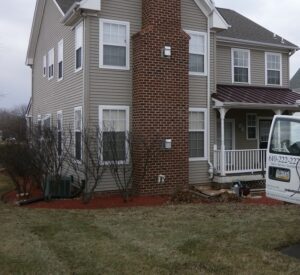Radon Remediation Cost and Methods
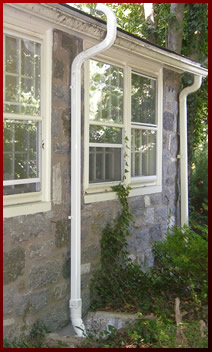 Radon remediation cost is dependent upon multiple factors and may vary from contractor to contractor. Effective radon remediation requires technical knowledge, years of experience and technical skills. Therefore, making an informed decision when considering a radon reduction contractor is vital. Check for certification on a state or national level and look for reviews or ask for references. The specialists at Radon-Rid, LLC are certified by the Pennsylvania Department of Environmental Protection to provide expert radon testing and radon remediation.
Radon remediation cost is dependent upon multiple factors and may vary from contractor to contractor. Effective radon remediation requires technical knowledge, years of experience and technical skills. Therefore, making an informed decision when considering a radon reduction contractor is vital. Check for certification on a state or national level and look for reviews or ask for references. The specialists at Radon-Rid, LLC are certified by the Pennsylvania Department of Environmental Protection to provide expert radon testing and radon remediation.
Factors That Determine Radon Remediation Cost
Remediation contractors make use of multiple types of systems, choosing the one that will be most effective in your home’s type of construction. The most common systems include sub-slab depressurization (most common method) and sub-membrane ventilation. During our consultation, we can talk about how to get rid of radon, assess which system is best for your home, and discuss the possible radon remediation costs.
Costs for a radon mitigation system to remove or reduce radon in your home can be impacted by a home’s age, design, size, type of foundation, and the types of construction materials used. Even the local climate can play a role, as can the personal preferences of the homeowner.
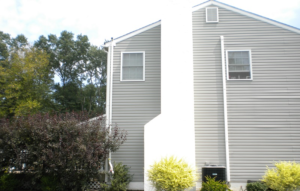 Homeowner choice can come into play when aesthetics are in question. In some new homes, systems have already been installed to help prevent high levels of radon gas from occurring. In existing homes, however, the radon mitigation system will have to be retrofitted. If the system is placed outside, the costs may be lower, but aesthetically, the results are less pleasing and could impact home value. If the system is placed inside, such as in a closet or less obvious place, additional costs might be incurred by the homeowner to run lines in such a way that they are unseen.
Homeowner choice can come into play when aesthetics are in question. In some new homes, systems have already been installed to help prevent high levels of radon gas from occurring. In existing homes, however, the radon mitigation system will have to be retrofitted. If the system is placed outside, the costs may be lower, but aesthetically, the results are less pleasing and could impact home value. If the system is placed inside, such as in a closet or less obvious place, additional costs might be incurred by the homeowner to run lines in such a way that they are unseen.
Below are some necessary elements that are part of your radon remediation costs:
- Special aesthetic considerations, such as keeping finished lower levels intact when adding pipes
- Crawl space materials such as barrier mats and specialized vents
- Seals and covers for sump pumps
- Energy-efficient fans
- Piping (more pipes may be necessary for larger homes)
Radon Remediation Solutions – Prevention and Removal
The radioactive gas known as radon is found in the soil and enters the home’s interior through the differential between air pressures: the low air pressure in the house and the high air pressure in the soil. Thus, reduction of high radon levels has two aspects:
- The prevention of entry of radon gas into the home (most effective)
- The removal of radon gas already present in the home
As mentioned, your home’s construction affects overall radon remediation cost and the system chosen as a solution. During the consultation, we assess the best system strategy according to your home. The most common method of radon remediation is sub-slab depressurization, the other less common method is sub-membrane ventilation.
Radon Remediation Methods at a Glance
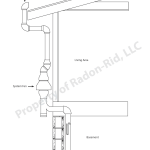 Sub-Slab Depressurization
Sub-Slab Depressurization
Sub-Slab Depressurization (or Sub-Slab Suction) is a radon remediation method that removes radon-laden air from beneath the foundation and vents the radon gas outside the home. This method works by installing a fan and inserting a pipe through the foundation into the aggregate below. The air can be vented to the outside of the house via an external set up or through an attic configuration. For a visual diagram of sub-slab depressurization, click on either the External or Attic configuration.
Two types of sub-slab depressurization are often used: active (ASSD) and passive (PSSD). The passive method works in the same basic way as the passive, however no fans are used. The system utilizes pressure differentials and natural air flow to vent the radon gas. The active system is considered more effective and is more common. Often passive systems are built into new homes as a preventive measure. These passive systems can be converted at a cost.
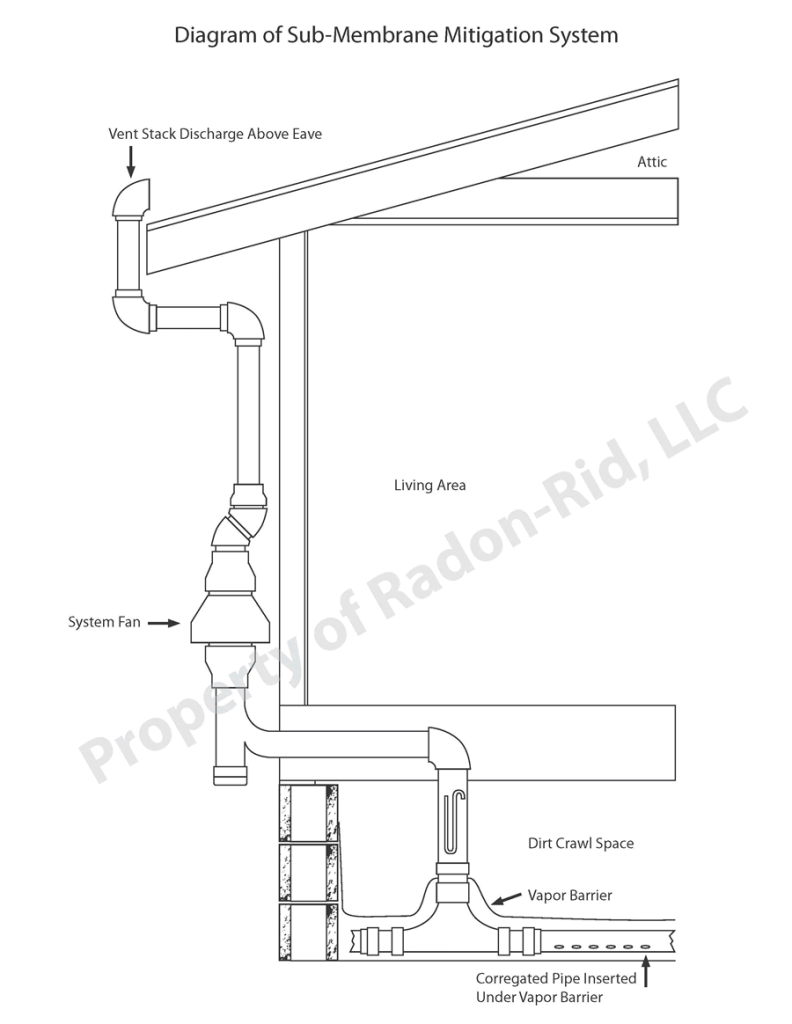 Sub-Membrane Ventilation
Sub-Membrane Ventilation
Sub-Membrane Ventilation (or depressurization) is similar to sub-slab depressurization, but is most effective at removing radon in buildings with earth-floored crawlspaces or basements, and uses a high-density polyethylene sheet barrier over the soil as a collection cover. A pipe or drain mat is inserted, along with a fan. The resulting “vacuum” allows the removal of the radon gas to the outdoors. For a visual diagram of sub-membrane ventilation, click on the Sub-Membrane configuration.
Block Wall Suction
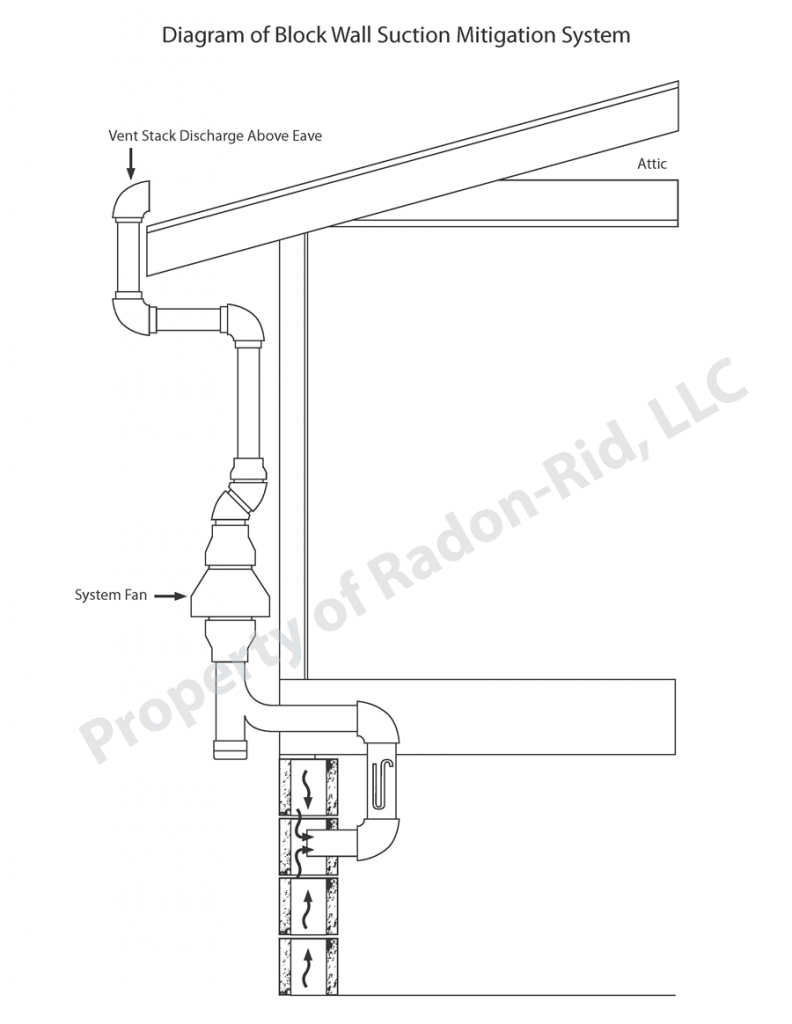 Block Wall Suction is a depressurization technique used on homes with hollow foundation walls. This type of system prevents radon from reentering the home. Block wall suction uses a fan and ductwork to draw suction on the hollow interior cavities of a concrete block wall. The method works by keeping the air pressure within the block wall lower than the air pressure in the basement, working to draw radon gas from the soil to be removed before it can enter the basement. For a visual diagram of block wall suction, click on the Block Wall Suction configuration.
Block Wall Suction is a depressurization technique used on homes with hollow foundation walls. This type of system prevents radon from reentering the home. Block wall suction uses a fan and ductwork to draw suction on the hollow interior cavities of a concrete block wall. The method works by keeping the air pressure within the block wall lower than the air pressure in the basement, working to draw radon gas from the soil to be removed before it can enter the basement. For a visual diagram of block wall suction, click on the Block Wall Suction configuration.
What Can Homeowners Do About Radon?
When trying to determine the levels of radon in a home, homeowners may be confused by conflicting test results. Weather can play a role when performing radon testing, so if you are performing a short-term test, which is common, you should avoid doing so during stormy weather.
Sealing can be an important element of radon remediation. In new homes, where settling is still occurring, sealing may need to be done each year to prevent degradation of the seals.
Ventilating your home can help reduce indoor air radon levels temporarily, once you find that you have above acceptable levels of the gas in your home. This solution is just a short term fix, however, as the resulting radon levels may still be too high, and you will likely be unable to continue keeping the open doors and windows through all seasons.
Trust Radon-Rid, LLC for Expert Radon Remediation and Testing
Radon is colorless, odorless, and tasteless gas that is undetectable except through testing. However, exposure to this invisible gas is the second leading cause of lung cancer, so if the gas is present in elevated levels (above 4.0 pCi/L according to the Environmental Protection Agency), remediation is vital for the safety of homeowners and their families.
Radon-Rid, LLC focuses primarily on customer safety and satisfaction and encourages customers to look no further when considering a radon expert. The customers come first, and Radon-Rid, LLC is willing to provide local referrals from other homeowners who have hired our services for radon testing, inspection and remediation. Contact us today to set up a consultation and learn how to protect your home from radon.
We Want to Help
"(required)" indicates required fields
Radon – The Silent Killer
Radon In Your Home
- Learn More About Radon Levels in Your County
- Take a few minutes to browse our Get To Know Radon Online Presentation.
- When you are finished, be sure to tell a loved one about our testing programs offered in Berks, Chester, Delaware, Lancaster, Montgomery & Philadelphia Counties.
